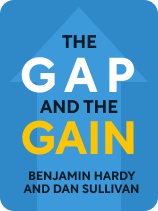

This article is an excerpt from the Shortform book guide to "The Gap and The Gain" by Benjamin Hardy and Dan Sullivan. Shortform has the world's best summaries and analyses of books you should be reading.
Like this article? Sign up for a free trial here .
What does “the gap and the gain” mean? What’s the difference between these two ways of measuring progress and success?
You might need to make one simple shift in your thinking. That’s the core idea of The Gap and the Gain that was developed by entrepreneurial coach Dan Sullivan. In the book, organizational psychologist Benjamin Hardy connects Sullivan’s ideas to scientific concepts that help explain why we tend to focus on the future and how we can train ourselves to focus on the past instead. Hardy and Sullivan argue that making this change can drastically improve your quality of life.
Keep reading to understand these mindsets and to learn how to focus on Gains rather than Gaps.
The Gap and the Gain
The Gap and the Gain describes two ways of thinking that measure your progress in life. Gap-thinking is focusing your thoughts on the “gap” between where you are now and where you want to be. Gain-thinking is focusing on how far you’ve come, or the “gains” you’ve made. According to the authors, both styles of thinking have significant consequences for your well-being: Gap-thinking is detrimental to your happiness, self-esteem, and physical health, whereas Gain-thinking improves these aspects of life.
(Shortform note: Although the authors argue that Gap-thinking damages your well-being, other experts suggest that thinking about the gap between your current self and your ideal future self can motivate you to achieve your goals. Researchers recommend two strategies to ensure that this gap is motivating rather than discouraging. First, make sure your goals are realistic enough that you can achieve them. Second, consider the obstacles that prevent your future from becoming a reality. This will allow you to figure out ways to get around these obstacles.)
Dan Sullivan, an entrepreneurial coach, provides several actionables he’s developed during his career to maintain a Gain-oriented mindset. While Sullivan provides these ideas, organizational psychologist and co-author Benjamin Hardy writes them into the book. Hardy also supplements Sullivan’s ideas with the psychological processes that explain how they operate.
Defining Characteristics
Gap-thinking and Gain-thinking are two different ways to interpret your progress or achievements in life, assert the authors. Knowing this, what are some key attributes of these mental frameworks that help you distinguish and understand them? We’ll elaborate on what Gap-thinking and Gain-thinking are by discussing the direction of comparison and the source of motivation for each.
Direction of Comparison
Comparison is the driving force behind Gap- and Gain-thinking, write the authors. Both mindsets involve comparing your present self to something else as a measurement of your achievements. The direction of comparison is what differentiates these two ways of thinking. Gap-thinking is measuring forward, or using your ideal future self as the object of comparison. Gain-thinking is measuring backward by using your past self instead.
(Shortform note: The authors also mention the practice of comparing yourself to other people—known in psychology as social comparison—which they classify as Gap-thinking. However, social comparison doesn’t fit neatly into this category because it can actually produce positive feelings under the right circumstances. For example, social comparison can motivate you when you focus on the similarities between yourself and a more successful person.)
The authors argue that measuring forward is unhealthy because of hedonic adaptation—a phenomenon in which you achieve your goal only to feel unfulfilled and wanting more. Because of this, you’re constantly updating your goals to be more ambitious, and you’re never satisfied with what you currently have. Instead, you should measure backward, because your past self is objective and immutable. This way, you have a consistent standard upon which to improve.(Shortform note: Hedonic adaptation is a well-documented phenomenon that limits the amount of happiness you get from a positive event or situation. Fortunately, psychologists have found several techniques you can use to bypass the effects of hedonic adaptation and increase your overall happiness. One method is making time for hobbies—activities during which you enter a “flow” state and lose track of time—because these are pleasurable in and of themselves. Another method is rotating your pleasurable activities so that they always feel new and exciting.)
Internal vs. External Motivation
Another distinguishing feature of Gap- and Gain-thinking is the source of motivation. When you fall into Gap-thinking, external factors motivate you. Your reference point—the standard against which you compare yourself—is an idealized version of yourself based on external standards set by other people. According to the authors, this removes any control you may have over defining what success means, which can leave you feeling helpless and unmotivated.
On the other hand, when you are in the Gain mindset, you are intrinsically motivated, assert the authors. You use your past self as an internal reference point. You are in complete control of what progress looks like because your past self sets the standard of success. According to the self-determination theory of psychology, having this control is crucial to feeling motivated and accomplished. Because Gain-thinking gives you control over how you define success, it helps you become more successful.
Cumulative Effects
Now that you know exactly what Gap- and Gain- thinking are, you may be wondering about the impact they have on your life. Hardy and Sullivan state that both Gap- and Gain-thinking have cumulative effects, meaning these effects accumulate and amplify themselves over time. These effects manifest in your daily life.
Gain-thinking is an inherently optimistic outlook. The authors conclude that Gain-thinking has therapeutic benefits for your body and mind. Alternatively, staying in the Gap mindset consistently can create toxic stress—a chronic form of stress that corrodes your mind and body over time. Trauma is the most extreme form of Gap-thinking. If you focus on your resentment of the fact that a traumatic experience happened at all—you’re stuck in the Gap mentality.
Gain-Thinking Techniques
Now that we’ve covered what Gap- and Gain-thinking are and how they can affect your well-being, we’ll discuss what you can do to focus on Gains instead of Gaps. In this section, we’ll provide techniques that will help you frame your past and present experiences in a way that promotes Gain-thinking.
Transform Your Past
There are two steps to overcoming trauma, say the authors. The first step is to organize your thoughts and feelings regarding the traumatic event (in other words, to understand the impact the event has had on you) by actively thinking about it instead of avoiding it. The second step is to transform your memory by thinking about the positive impact the event has had on your life. Think about what you learned from the experience and what about the event you’re grateful for.
Gains Today, Gains Tomorrow
After you transform your past, be vigilant in the present about staying in the Gain mindset. There are three basic tenets of maintaining Gain-thinking: 1. Practice gratitude, 2. Plan ahead for the future, and 3. Hold yourself accountable.
Exercise: Turn Misfortune Into a Gain
Consider how you can shift your Gap-thinking to Gain-thinking using a recent event in your life.
- Think about a recent event in your life that put you in the Gap mentality. What were your Gap thoughts? In other words, what was going through your mind as you were stuck in the Gap? What idealized version of your future self were you comparing your present self to?
- What did this event teach you about yourself, other people, or the world at large?
- How will you use what you’ve learned from this event to act or think differently in the future?
- What about this event are you thankful for? Why?

———End of Preview———
Like what you just read? Read the rest of the world's best book summary and analysis of Benjamin Hardy and Dan Sullivan's "The Gap and The Gain" at Shortform .
Here's what you'll find in our full The Gap and The Gain summary :
- Why you must compare who you are now to who you used to be
- Why you should focus on your past rather than your future
- How Gain-Thinking can improve your happiness, self-esteem, and physical health






